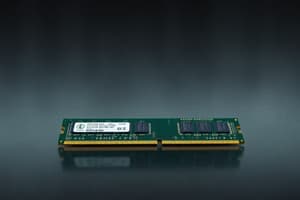Podcast
Questions and Answers
What is a characteristic of SRAM?
What is a characteristic of SRAM?
- It stores data in a flip-flop circuit (correct)
- It stores data in capacitors
- It is slower and less expensive than DRAM
- It is non-volatile and has low power consumption
Which type of ROM can be erased using ultraviolet light?
Which type of ROM can be erased using ultraviolet light?
- Mask ROM
- EEPROM
- EPROM (correct)
- PROM
What is the primary storage for data and programs?
What is the primary storage for data and programs?
- Level 2 Cache (L2 Cache)
- Secondary Storage (Hard Drive, SSD, etc.)
- Level 1 Cache (L1 Cache)
- Main Memory (RAM) (correct)
What type of DRAM is synchronized with the CPU clock?
What type of DRAM is synchronized with the CPU clock?
What is a characteristic of FRAM?
What is a characteristic of FRAM?
Flashcards are hidden until you start studying
Study Notes
Computer Memory
Types of RAM
- SRAM (Static RAM):
- Stores data in a flip-flop circuit
- Faster and more expensive than DRAM
- Typically used as cache memory
- DRAM (Dynamic RAM):
- Stores data in capacitors
- Slower and less expensive than SRAM
- Widely used in computers and other devices
- FRAM (Ferroelectric RAM):
- Uses a ferroelectric material to store data
- Non-volatile, fast, and low power consumption
- Used in specialized applications
- SDRAM (Synchronous Dynamic RAM):
- A type of DRAM synchronized with the CPU clock
- Faster than traditional DRAM
- Widely used in computers and other devices
ROM Types
- Mask ROM:
- Data is programmed during manufacturing
- Permanent and cannot be changed
- Used in devices where data is not expected to change
- PROM (Programmable ROM):
- Data can be written once, but not erased
- Used in devices where data needs to be written once
- EPROM (Erasable Programmable ROM):
- Data can be erased using ultraviolet light
- Used in devices where data needs to be updated occasionally
- EEPROM (Electrically Erasable Programmable ROM):
- Data can be erased and written electronically
- Used in devices where data needs to be updated frequently
Memory Hierarchy
- Level 1 Cache (L1 Cache):
- A small, fast cache built into the CPU
- Stores frequently used data and instructions
- Level 2 Cache (L2 Cache):
- A larger, slower cache outside the CPU
- Stores less frequently used data and instructions
- Main Memory (RAM):
- The primary storage for data and programs
- Slower and larger than cache memory
- Secondary Storage (Hard Drive, SSD, etc.):
- Non-volatile storage for data and programs
- Slower and larger than main memory
Studying That Suits You
Use AI to generate personalized quizzes and flashcards to suit your learning preferences.




